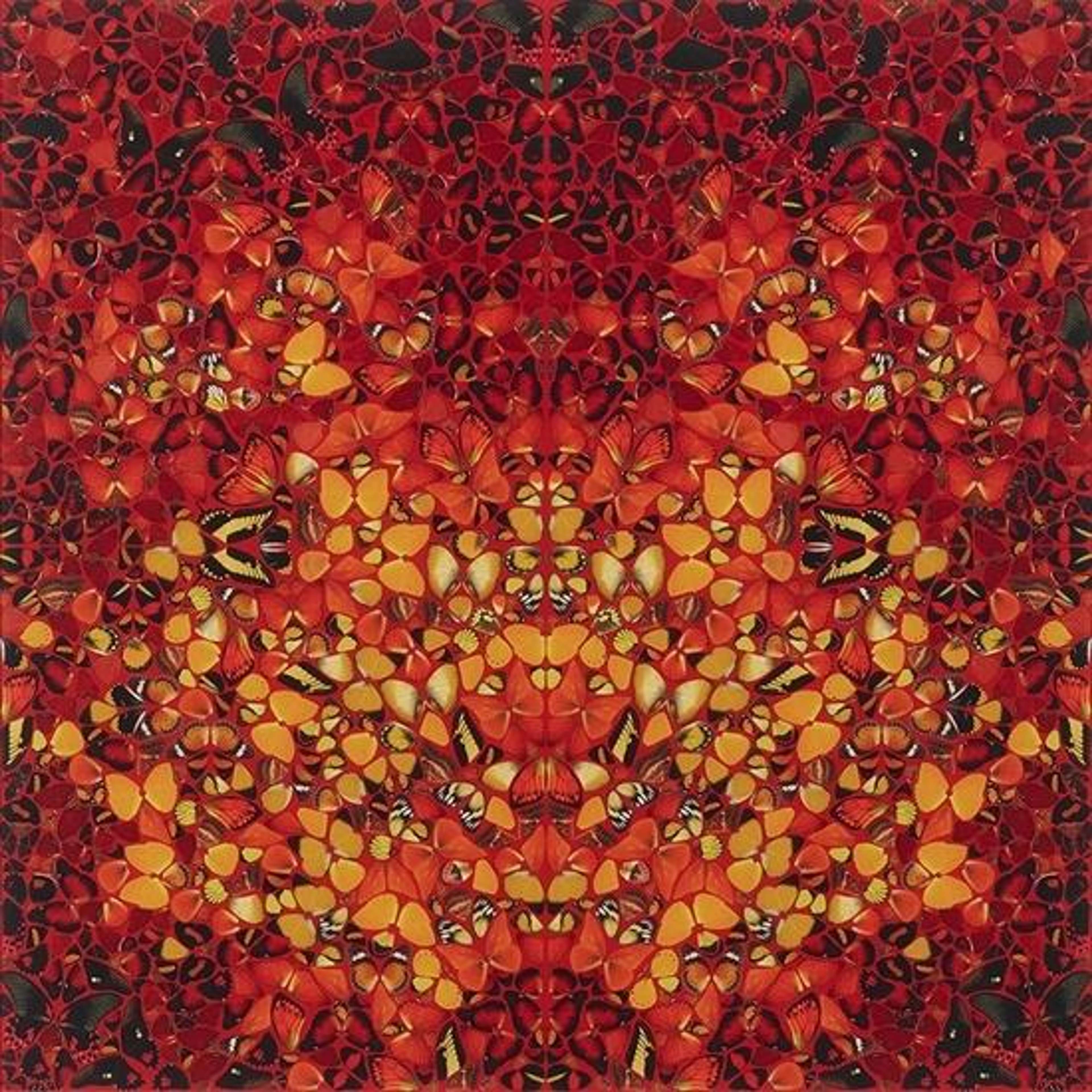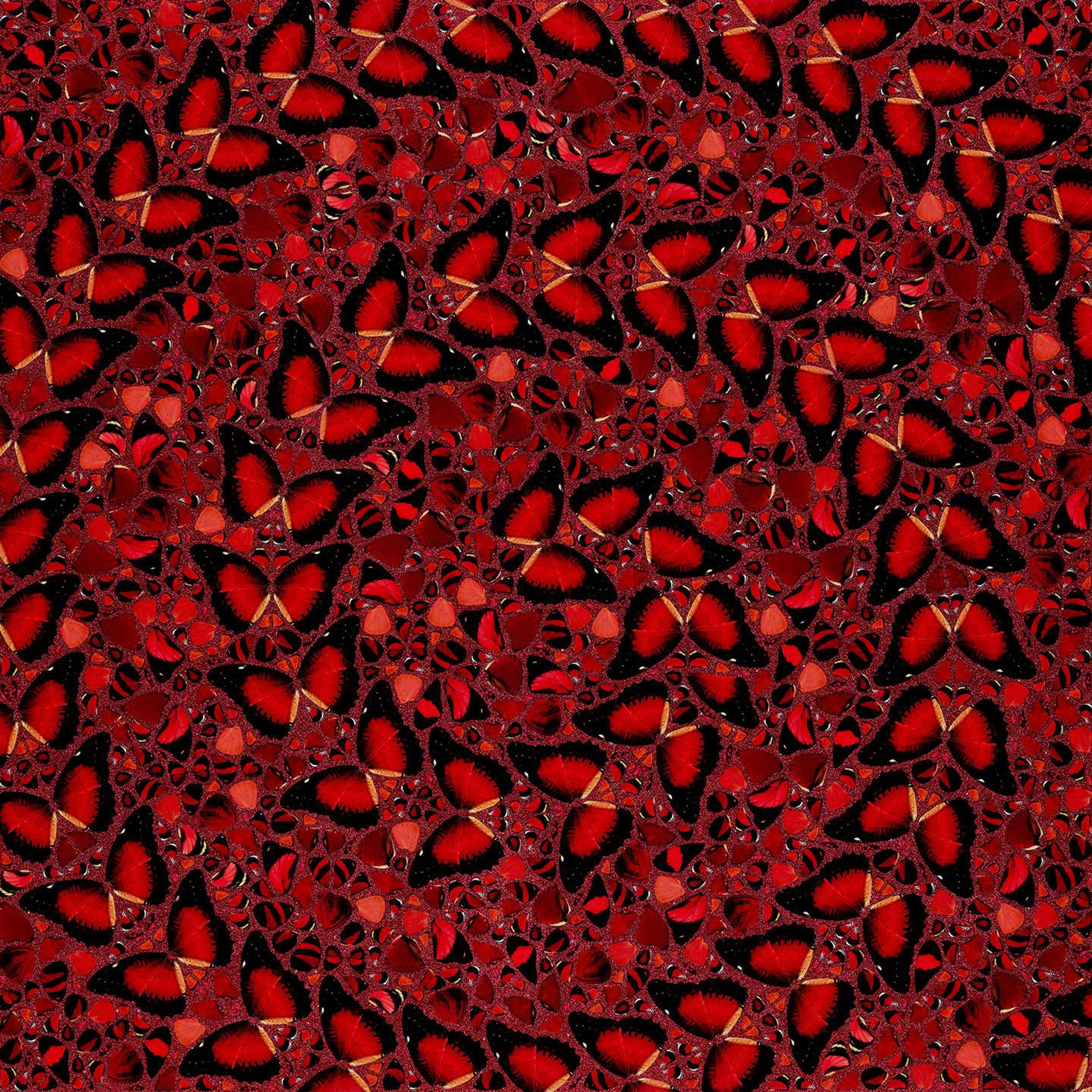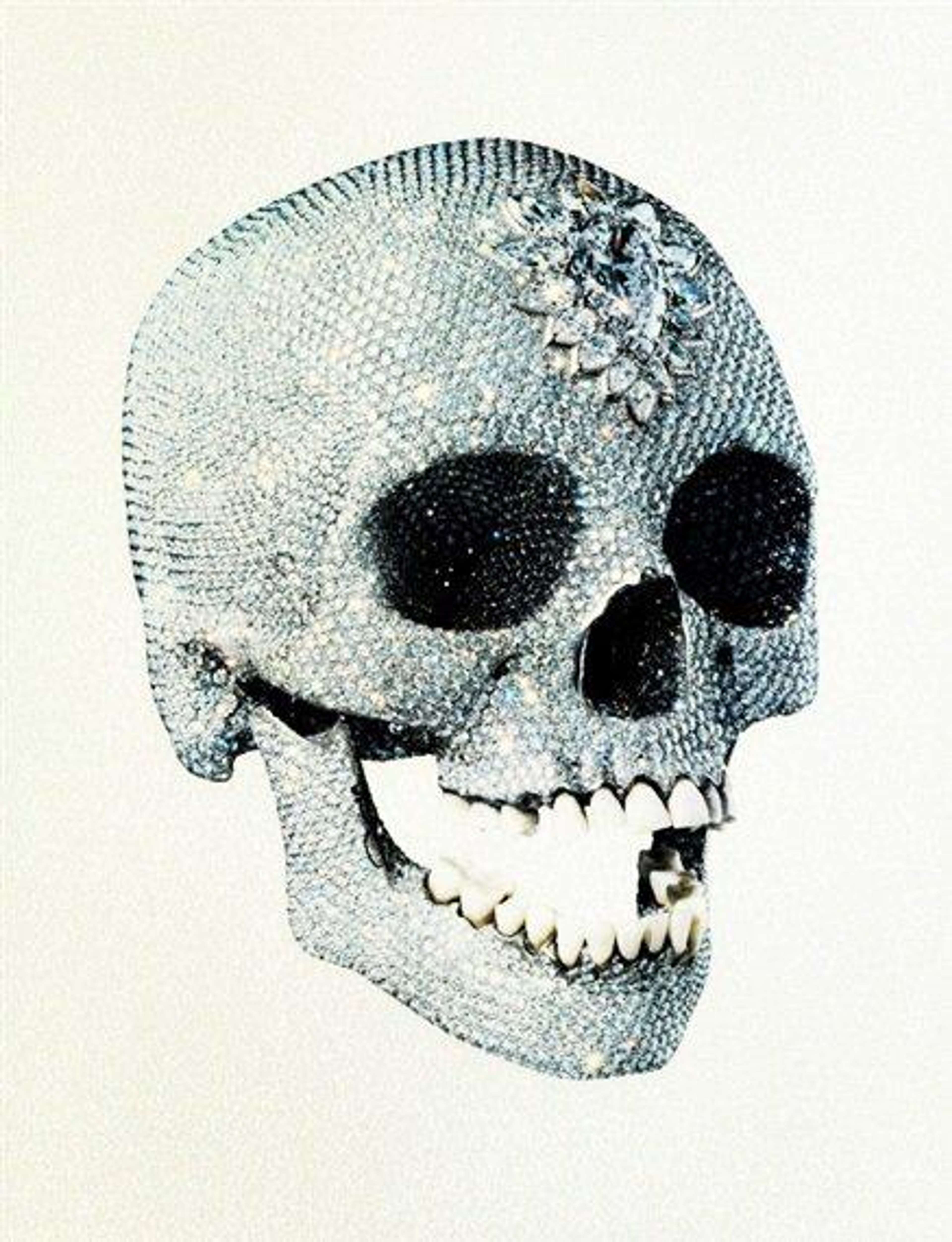 Canon © Damien Hirst 2015
Canon © Damien Hirst 2015
Damien Hirst
677 works
Few artists capture the provocative marriage of art and science as well as Damien Hirst. From his formidable formaldehyde to his controversial cures, the pharmacist artist’s oeuvre invites viewers into a playground of mortality, medicine, and metaphysics. Each piece, rich with layers of commentary and cultural context, challenges societal interpretations, leaving viewers curious about where exactly, if they exist at all, do the boundaries of art end, and the precision of science begin?
Hirst's Evolution: From Shock to Sublime
Hirst’s journey, charting a course from his early days as a leading figure in the Young British Artists (YBA) movement to his more recent endeavours, displays a remarkable evolution from shock to subtlety, yet retains a consistent thread of provocation and inquiry. In the YBA era, Hirst gained notoriety for his audacious and often controversial pieces.
As his career progressed, Hirst began to shift towards a more nuanced exploration of similar themes. This transition is evident in his later works, which, while less shock-inducing, are equally thought-provoking. The incorporation of pharmaceutical motifs and the prismatic butterfly series mark a move towards a relaxed yet richly layered expression. In these works, Hirst dives head first into metaphysical questions, the intersection of science and art, and the human condition's complexities, reflecting a maturity and depth in his approach to art. His journey mirrors the evolution of contemporary art itself, navigating through shock value to a more reflective engagement with life's fundamental questions.
Pharmaceuticals as Artistic Motifs
Hirst employs pharmaceuticals as potent vehicles to provoke dialogue. His collections, The Cure, Utopia, and The Last Supper display pills, medicine cabinets, and pharmacological constructs that transcend their traditional representation, reflecting society's complex relationship with medicine. In the sterile neatness of his drug-laden shelves, there is an echo of modernity's obsession with order, control, and the elusive promise of health. The pill—a small, encapsulated unit of potential healing or harm—becomes a microcosm of the medical industry's duality in Hirst's art.
This duality is exemplified in Hirst’s Pharmacy installation, where rows upon rows of drugs in pristine order connote a silent battlefield between life and death, wellness and ailment. The viewer is ushered into a space of reflection about the commodification of health, the aesthetics of medicine, and the placebo effect of art itself. Through this motif, Hirst invites an assessment of our faith in pharmaceuticals—our modern-day remedy—as well as a confrontation with the limitations and commercialisation of contemporary medicine.
Damien Hirst's Butterflies: Metamorphosis and Meaning
Hirst’s dialogue with life, receives a mesmerising expression in H6 The Elements. In this series, we see kaleidoscopic patterns from thousands of butterfly wings mounted on aluminium, each piece a homage to one of the four foundational substances—earth, air, fire, and water—each in their own unique colour palette. The variance in hues from the fiery reds and oranges of H6-8 Fire to the tranquil blues of H6-9 Water encapsulates the believed harmony necessary for spiritual vitality, a concept once integral to both Eastern and Western traditions and the root of medicine.
In H-10 The Empresses, the butterfly—a recurring symbol in Hirst’s catalogue—takes on a glittering form, with each print named after historical empresses whose reigns were significant to cultural advancements. The use of glitter on laminated giclée prints affords each work a tangible vivacity, juxtaposing the static nature of death with the shimmer of life. These empresses, from Wu Zetian to Taytu Betul, are immortalised through the iridescent beauty of butterfly wings, underscoring Hirst’s assertion of the insect’s aesthetic endurance, even post-mortem.
The Intersection of Nature and Art in Damien Hirst's Entomology Collection
Hirst's Entomology Works presents an elaborate arrangement of insects, each carefully placed to create sophisticated patterns that evoke both beauty and curiosity. Utilising a diverse selection of sizes and species, Hirst crafts works that captivate, drawing inspiration from their namesakes in Dante Alighieri’s The Divine Comedy. Whereas Alighieri's epic poem journeys through the inferno with the guidance of literary elements, Hirst's visual composition suggests the perpetual cycle of life through works that are as unsettling as they are delicate.
Controversial Conservation: The Ethical Debate in Hirst's Use of Formaldehyde
The interplay of Hirst's artwork with scientific themes does not come without its ethical and philosophical conundrums. As his pieces navigate the realms of the organic and inorganic, living and deceased, they naturally stir a pot of ethical debate. Hirst's use of animal bodies, for instance, in works such as The Physical Impossibility Of Death In The Mind Of Someone Living — the infamous tiger shark suspended in formaldehyde — forces a confrontation with the moral dimensions of sourcing and displaying once-living creatures as art. The underlying question is one of boundaries: How far can one push the envelope in the name of art before transgressing the borders of ethical propriety?
Other works including Mother And Child Divided, a bisected cow and calf preserved in formaldehyde tanks, and Away From The Flock, a lone sheep suspended in the same preserving agent, intensify this debate. They stand as visceral examples of art’s intrusion into the inevitable, showcasing death as both spectacle and study. These works have drawn significant criticism and protest from animal rights groups, who argue that the commodification of dead animals for the sake of artistic expression is a form of cruelty and exploitation that disregards life’s intrinsic value.
 Image © Tate Modern / Away From The Flock © Damien Hirst 1994
Image © Tate Modern / Away From The Flock © Damien Hirst 1994The artist’s defence operates on the idea of bringing the viewer into a direct, unflinching relationship with the reality of death, a concept often sanitised and pushed away from public discourse. Hirst's work forces an acknowledgment of our own mortality, the natural processes we often ignore, along with the scientific practices of dissection and preservation.
However, the contention over whether art should possess such licence to appropriate the remains of once-living beings remains unresolved. Critics question if the shock value and the dialogues elicited by these works justify the means, or if they overshadow a deeper engagement with the themes of life and death that Hirst purports to explore.
The Debate Over Artistic Licence and Scientific Integrity
This discussion segues into the broader discourse on artistic licence and scientific integrity. Hirst's foray into pharmaceutical and anatomical works raises questions about the sanctity of scientific or academic domains. His work often prompts the viewer to question the appropriation of biological iconography: does its use uphold the rigour of science, or trivialise it? Hirst challenges the guardians of these traditions, posing a provocative inquiry into whether art has the right to repurpose science for aesthetic and conceptual pursuits.
On a philosophical front, Hirst's art triggers a meditation on the very nature of existence. The confrontation with death, decay, and the often overlooked aspects of the biological journey of life invites reflections on the human condition. It is here, within this web of sciences and aesthetics, that Hirst arguably finds the most fertile ground for his creative explorations. His work compels viewers to grapple with the uncomfortable, often taboo subjects shrouded in the visuals of scientific imagery, forcing a contemplation on the fragility and temporality of life itself. As such, his work becomes a catalyst for a philosophical discourse that wrestles with the ethics of representation, the limitations of art, and the responsibilities of artists in the crosshairs of public scrutiny and scientific accountability.
Curating Controversy: Building a Damien Hirst Art Collection
In the past decade, the auction outcomes for Hirst's art have been predominantly led by pieces valued at less than $10,000, indicating that his print editions are experiencing a surge in popularity, possibly even outpacing the demand for his original works. Notably, there's been an increase in interest for comprehensive sets of his works, which now make up 15% of his total print market in secondary sales, reflecting a heightened collector interest in acquiring complete series of his prints.
One of those sets, H10 The Empresses (complete set), had an impressive sale recently going for £27,940 (fees included), reflect not only its aesthetic appeal but also their resonance with art collectors who are looking for a savvy art investment that has a visual impact and embodies bold conceptual art. For art investors, Hirst’s prints represent an intersection of artistry and art market viability. Hirst’s prints outlive fleeting trends with value derived from their scarcity and potential to appreciate in value over time. Art collectors are often drawn to the way these prints offer a more accessible form compared to Hirst’s installations or larger-scale pieces.
 MAB100 Print Market Index © MyArtBroker 2023
MAB100 Print Market Index © MyArtBroker 2023MAB100: The Art Print Edition Market Index
With the launch of MAB100, MyArtBroker has developed a list of the top 100 artists, guiding investors toward the most sought-after pieces, informed by comprehensive market reports that analyse trends and provide insights into the art world's currents and potential future directions. This carefully crafted index is powered by a custom-built algorithm designed to track and analyse the liquidity and market prominence of art prints.
It ranks the selected artworks based on cumulative spending, thus ensuring that investors have access to a list that reflects both current value and potential for appreciation. By integrating trend analytics, the MAB100 doesn't just report on the market—it anticipates its movements. Offering direct access to this wealth of data, MyArtBroker has made auction-level analysis and price discovery readily available, streamlining the investment process for art collectors worldwide.
Damien Hirst's Contribution to Contemporary Art Dialogue
As a pivotal figure in the art world, Hirst’s work has continually challenged and reshaped the boundaries of modern art. Emerging from the Young British Artists movement, Hirst brought a new audacity and conceptual depth to contemporary art, using his platform to explore and often provoke discussions around mortality, science, and the nature of beauty. His iconic pieces, ranging from the controversial use of animals in formaldehyde to his intricate butterfly compositions, have not only sparked debates but also inspired a new generation of artists to push the limits of artistic expression.
By continually reinventing his approach and challenging conventional art norms, Hirst has played a crucial role in shaping the trajectory of contemporary art, ensuring its relevance in an ever-changing world. His legacy lies not only in his individual artworks but in his enduring impact on the dialogue and direction of contemporary art.













